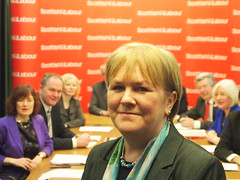Scottish Labour after a Yes vote
Scottish Labour seem to be spending all their resources on attacking the SNP in every way possible and on spreading fear and uncertainty about the prospect of Scottish independence. We haven’t heard much about their visions for Scotland after 2014, no matter whether we vote Yes or No, apart from their determination to introduce university tuition fees and possible also prescription charges.
However, I hope and believe they’ll change after a Yes vote. Here’s how I imagine the process would work:
The day after the referendum (autumn 2014) — Scottish Labour press conference with Johann Lamont, Alastair Darling and the Scottish members of the shadow cabinet in Westminster, Douglas Alexander, Jim Murphy and Margaret Curran. They declare that although they’re disappointed with the result, they will respect it, and they will work with the SNP and other Scottish parties to achieve the best possible deal for Scotland in the independence negotiations. Douglas Alexander, Jim Murphy and Margaret Curran resign from the Shadow Cabinet.
Late 2014 — Scottish Labour sever all ties to rUK Labour.
Late 2014 — The Scottish independence negotiation teams are announced. The SNP’s Nicola Sturgeon will head the main team, but Labour politicians get to lead several of the important teams, in particular Douglas Alexander who becomes the head of the foreign affairs team and Jim Murphy who is put in charge of the defence negotiations. Several Liberal Democrat and Conservative politicians also get chosen to lead negotiation teams.
Late 2014 — Several Scottish MPs announce they will apply for rUK citizenship and stand for Westminster seats in England. At the same time, some Scottish MPs representing English seats declare their intention to move back to Scotland and try to get into the Scottish Parliament in 2016.
Late 2014 — A few Labour MSPs give up their seats “for health reasons”. Douglas Alexander, Jim Murphy and Margaret Curran decide to contest these seats. They are duly elected without too much trouble.
Early 2015 — Johann Lamont decides to resign as leader of Scottish Labour because her leadership was too closely tied to the failed Better Together campaign. Douglas Alexander, Jim Murphy and Margaret Curran all decide to run for leader. After an intense campaign, Jim Murphy becomes the new leader of Scottish Labour. [I’m not implying here that Jim Murphy is Labour’s best politician, but he happens to be my local MP.]
7 May 2015 — Westminster elections. By common consent, all main parties in Scotland decide not to put up challengers to the incumbents, given that independence is now only a year away.
April 2016 — Scottish Labour launch their manifesto for Scottish Parliament elections. Now that they can develop their own policies without undue interference from London, they’re suddenly against tuition fees and prescription charges again.
1 May 2016 — Independence Day.
5 May 2016 — Elections to the Scottish Parliament. The winner is unexpectedly Labour, and Jim Murphy becomes Prime Minister of the Kingdom of Scotland.

@widmannblog Really? Kingdom of Scotland? Under E2?
Although I’d prefer a republic, Scotland will realistically immediately after independence be a monarchy under Elizabeth, Queen of Scots.
Thats it Thomas, my party card is getting melted now. I havent worked nearly 40 yrs in the SNP and wider independence movement to see shite like Murphy become PM.
An interesting analysis, however but there is no way we’d let let clowns like Alexander and Murphy head up ANY kind of negotiation team for the country.
I know what you mean, Willie, but what I’m trying to express is that an independent Scotland won’t be a one-party state ruled in perpetuity by Salmond. The thing is that as soon as independence has been achieved, normal politics will resume, and the main dividing line in Scottish politics won’t be independence vs. unionism, but left vs. right or something.
It’s entirely possible that all of Labour’s current leading lights will be too tarnished by the Better Together campaign to ever get any influence in an independent Scotland, and that Labour’s main politicians after independence will be those that are staying on the sidelines at the moment.
What I find fascinating, too, is how long it’ll take the Better Together team to accept independence after a Yes vote. Only time will tell.